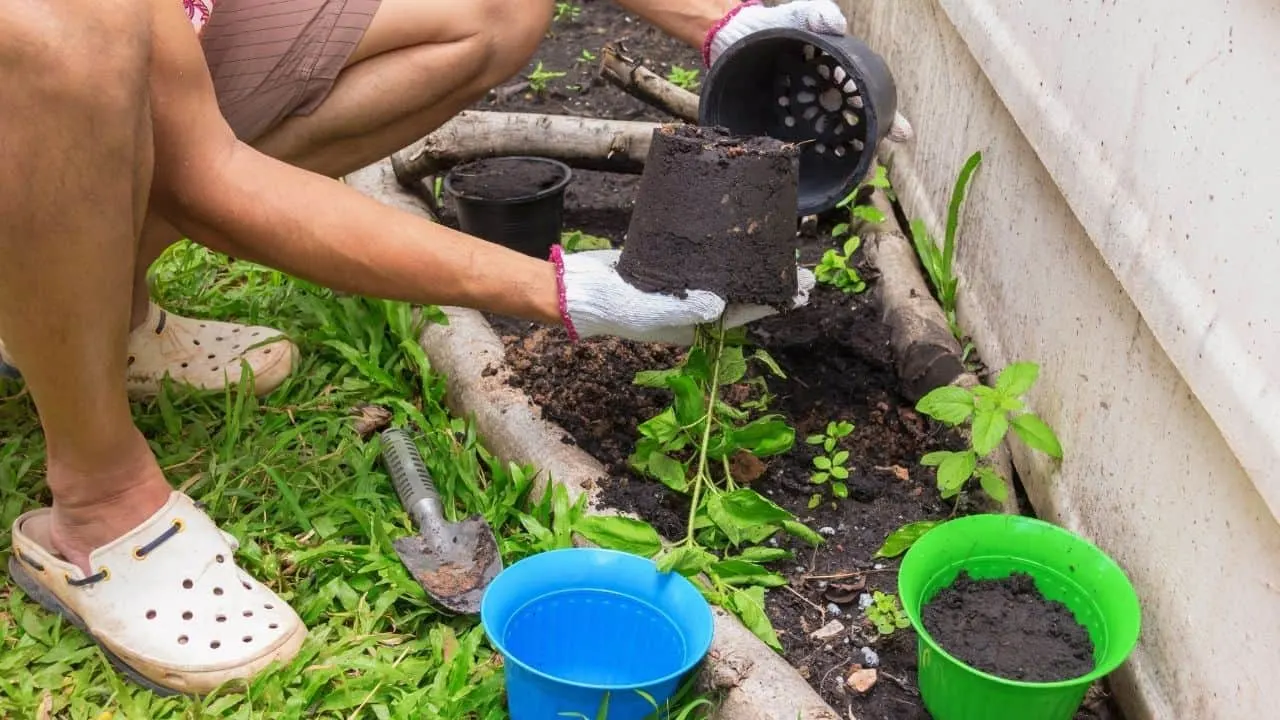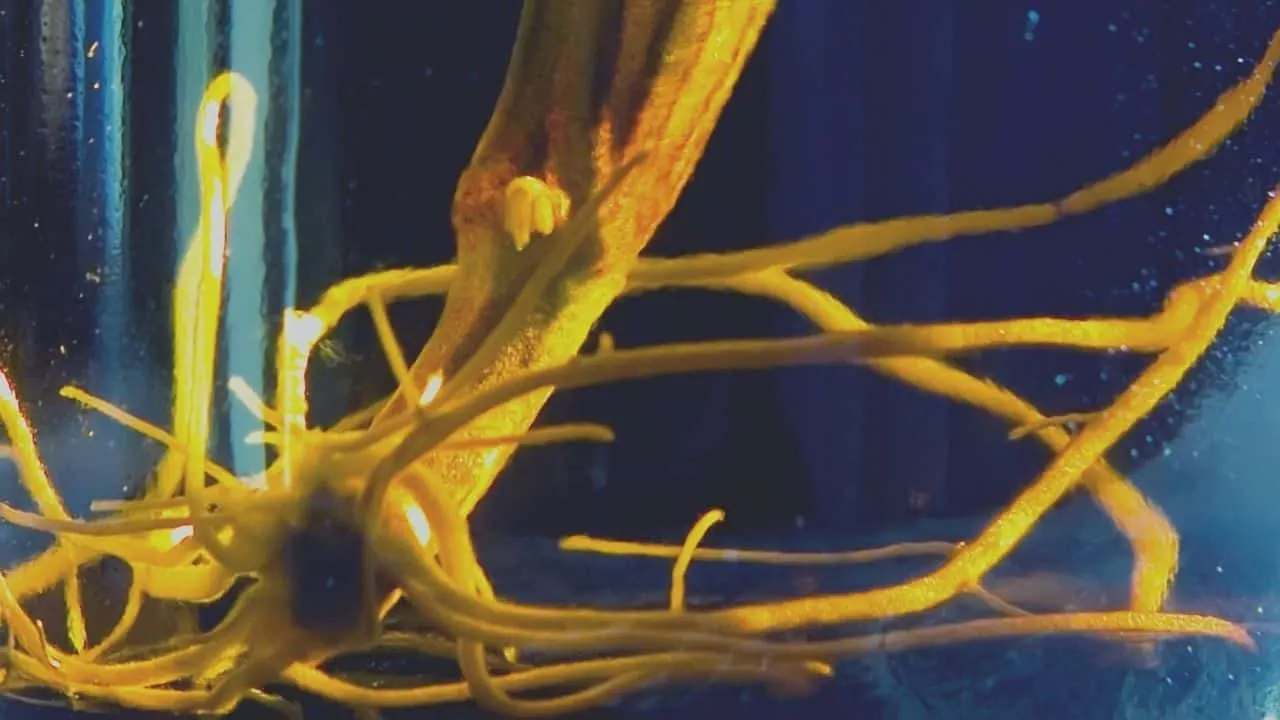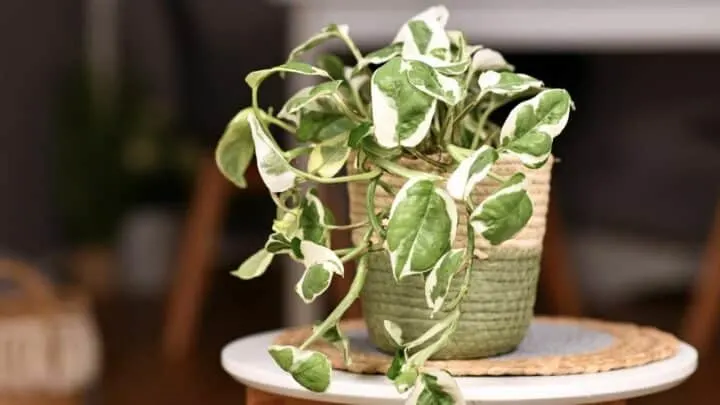Among my favorite houseplants is NJoy Pothos, the one that sparked my interest in having a home full of green plants all around.
Initially, I was drawn to the beauty the plant added to my home. But when I researched more about the plant, I discovered it was a versatile plant with multiple other benefits.
Moreover, the signature mottled white and green variegation of the leaves could not stop me from opting for this plant.
Although there are numerous names people call the plant by, like NJoy Pothos or Pothos NJoy, one thing is assured: planting this species in your home will get you to reap many benefits that you were not aware of.
For home growers like us, getting to plant and see the plant all around your indoors, N Joy Pothos will serve as a sight to NJoy.
The speckled-looking variegation plant belongs to the Araceae family.
The Njoy plant species originates primarily from the Marble Queen Pothos from various parts of Australia and Southeast Asia.
Since the small and bushy species have a lot to offer for plant lovers, read on to discover all about these ornamental-looking Pothos.
Table of Contents
N Joy Pothos Care
As far as care goes, Pothos NJoy is an easy-to-grow species that needs moderate indirect light and does also well with artificial lighting. The plant is happiest when grown in moist soil and temperatures between 18 to 29 degrees Celsius (65 to 85 degrees Fahrenheit). Add some perlite to the soil for extra drainage.
The Ultimate NJoy Pothos Care Guide You Need to Know
Surprisingly, NJoy Pothos is one of those striking varieties of houseplants that will make you indoors look marvelous without much time and care, unlike other houseplants.
To have a thriving NJoy plant, all you need to know are the basics of caring for the plant.
You would be surprised by how beautiful, fresh and lively the plant will make your environment.
Soil
I prefer growing N-joy over other plants because it is not picky about the soil it is planted in.
However, this does not mean you will pick a potting mix with minimum qualities for your plants’ growth. This would be a direct invitation to pathogens and pests that I would never recommend.
All you need to consider when it comes to the choice of soil for your plant is the drainage of the soil, preferably a sterile media.
To keep my NJoy Pothos happy and healthy, I try to get a potting mix that maintains the balance between retaining water and drainage. Adding some perlite to the soil also does the trick.
Ensure that the pot’s got plenty of drainage holes so it can remove the excess water.
Light
Like most Pothos plants, NJoy Pothos will not make a fuss about how much light you provide it with.
However, I suggest a moderate indirect light to promote maximum growth and see a beautiful green hue on the plant.
Even if you place the plant in a dark area that receives artificial light, the growth of NJoy will not disappoint you. However, you will observe the bright variegation fading gradually.

Similarly, direct sunlight means damaging the tiny heart-shaped leaves of the plants and causes them to wither.
The sign I prefer to spot is the plants’ leaves greening. The greener your plant is, the happier it is with its lighting conditions, and vice versa.
Watering
N Joy does not enjoy it when they are put in a soaking-wet pot. Likewise, they hate being left completely dried too.
So, you’ve got to ensure you don’t underwater or overwater this plant species.
Typically, they require a little water to grow best. To test this, I would suggest you put your index finger more than an inch deeper into the soil and check if the soil is dry or wet.
If the layer is wet, you are probably overwatering, and if it is dry, the plant needs some water to grow happily.
Most importantly, do not stick to one watering schedule; be flexible according to your plant’s water needs.
Temperature
The species come from tropical regions; the most suitable temperatures for this Pothos type’s growth are between 18 to 29 degrees Celsius (65 to 85 degrees Fahrenheit).
If you keep them at a temperature that is below 55 degrees Celsius (55 degrees Fahrenheit), their survival becomes difficult.
All in all, it would be best if you could keep these bushy species away from too-cold or too-hot temperature conditions.
I usually place these plants in places where the temperature is optimum, neither too cold nor too hot, at room temperature.
Keep in mind to keep NJoy Pothos away from the heating and air conditioning units of your home.
Humidity
One factor that your NJoy loves in abundance is humidity. I was amazed by the wonders a humidifier brought to my plant.
I first realized that placing the plant in higher humidity benefits the plants in multiple ways.
So, you can place it in a place with high humidity levels, or you can even use a balanced liquid fertilizer or a humidifier every month to see the profitable growth of your plant.
You can even choose the plant’s location with good airflow and high humidity to keep your Pothos species away from diseases.
Fertilizer
For the healthy and robust growth of your NJoy, fertilizer can be an add-on.
Not that you need to get fertilizer to grow this Pothos, but if you add some excellent fertilizer to the potting soil, it will work like magic.
I prefer adding a well-balanced fertilizer because most of the potting soils that we use today do not have all the nutrients essential for the fuller growth of the plant.
You can use a houseplant fertilizer once or twice every month. The best time to feed NJoy Pothos is during the summer and spring season (the growing season).
Propagation
I usually propagate my NJoy Pothos to cut them short and plant them in different corners of my house. There’s nothing simpler than propagating an NJoy.
All you need to do is adopt the stem cutting method, take a cutting and plant it in another pot.
One mistake that most people make while propagating is that they do not use a healthy-looking stem.
So, preferably, go for a stem that looks green and healthy and has no more than three to four leaves for ideal propagation.
Growth
When I first grew Pothos NJoy, it went up to the height of eight feet. I was pretty surprised by the tall growth of the plant species.
In the wild, the plant can grow around fifty feet and more, whereas, in homes, it is likely to grow around six to nine feet.
Overall, if you offer the plant the optimal conditions for growth, it is likely to grow several feet.
Unlike most Pothos, the size of the leaves of an NJoy is comparatively smaller. The hue of the leaves slightly varies with the light conditions the plant is exposed to.
As far as the plant’s life is concerned, it is said that the plant can live up to twenty-two weeks after its complete growth.
Potting
At times, you will observe that your plant has become bound to the pot. You need to know that the plant’s roots have expanded to their maximum capacity when this happens.
There’s no more room left for the N Joy pothos to expand, thereby restricting the plants’ growth.

I spotted wilted leaves despite providing optimum conditions to my NJoy Pothos when it became pot-bound.
In such situations, pick a larger pot and shift your plant into it. Keep in mind to fill the new pot with fresh soil.
How to Propagate N Joy Pothos
Usually, Pothos NJoy is not likely to flower, so the most common and easy method that I find to propagate the plant is through cuttings.
All you need to do is identify a healthy-looking stem with as much variegation as you want in your new plant.
I would recommend you pick a vine with a minimum of four leaves and some nodules at its base. The roots and leaves grow from the stem’s nodes.
Hence, ensure to pick the stem having a minimum node at least.
For better propagation, place the cutting in water that consists of essential nutrients. I used nutrient-infused water and observed lots of growth.
Also, remove the leaves below the surface.
After planting your cutting in the water (or soil), you will observe roots coming out in around two weeks or less, depending upon the conditions provided to your plant.

Initially, I placed the water container in an area with average room temperature for the propagation stage, having indirect bright light.
If you want robust growth propagation, then keep checking the water level in the container. Also, ensure to change it once a week to provide clean water to promote NJoy Pothos plants’ growth.
After the roots are visible, you can shift your plant into a soil pot if you want to, as later it will be too late, and the roots will grow bigger.
So, choose to place your N Joy pothos in the soil or water.
I prefer waiting for the roots to grow up to two to three inches before transferring my plant. After transferring, take care of the plant under the same condition as the parent plant.
Common Problems Your N Joy Pothos May Face
Although Pothos NJoy is an easy-to-care plant and can resist problems like that of pests and diseases, there are still chances that your plant may face serious problems.
To keep your plant miles away from such problems, you should know these problems first off.
Your NJoy is likely to be attacked by pests. Although these are not susceptible to them, this can be a problem.
At times, pests like plant scale, whiteflies, mealybugs, and spiders are likely to damage your houseplant.
To keep a check for pest attacks, look below the leaves now and then. Your N Joy Pothos will stop growing if it’s having a nasty pest infestation.
When you observe your plants not growing like they previously did, I suggest you check if you supply the plant with all the sufficient nutrients it needs.
Your plant may be also be infested by some insects, so keep a check.
Overwatering is another common problem that arises while planting N Joys.
Whenever you see brown patches on the heart-shaped leaves, reduce the amount of watering immediately. Brown patches can also be linked to placing the plant in direct or intense light.
You need to take care of your plant when the nodes are rooting because bacteria are likely to attack your plant and bring an end to the propagation process.
When my plant suffered from the bacteria-wilt disease, I observed the stem and leaves turning black within no time.
How to Prevent N Joy Pothos Problems
If your plant faces at least one of the problems mentioned earlier, then do not worry. I’m laying out all the tips here that I find effective when tending to my N Joy pothos.
For pest control, I would suggest you purchase insect control soap. Mix the insect control soap with water before spraying it on your Pothos NJoy.
The best solution to prevent your plant from wilting is moving it to where it receives indirect sunlight, preferably a shaded area.
When your plant turns black and stunted growth, transfer the plant into a different pot with new soil.
Fortunately, my plants were rarely affected by any of the common problems because:
- I used standard potting soil with a pH varying from 6.2, having good drainage properties.
- I placed the plant in my living room, right beside my window, where my NJoy Pothos received bright but indirect sunlight.
- I ensured keeping it away from heating and cooling appliances to maintain the room temperature for optimum growth.
- I checked my topsoil frequently and changed my watering schedule accordingly.
Read more about the care for Epipremnum aureum here.
Frequently Asked Questions about NJoy Pothos Care
Which is the Most Suitable Pot for Growing NJoy?
N Joy can be grown in any pot. However, ensure that a pot has at least one hole for draining excess water.
Is the Plant Toxic for My Pets and Children?
Being a member of the aroid family, the houseplant is toxic. If ingested, it can irritate living organisms.
Why are the leaves of my Pothos so small?
If your N Joy Pothos has small leaves, it is probably due to a lack of good light. Hence, ensure to provide your plant with optimum growing conditions.
Conclusion
If you want to fill your space with a plant that does not require much time and care, has a bushy growth, and looks beautiful, then NJoy Pothos is the right choice.
I was surprised by the benefits and beauty the plant brought to my home. If you also want to have the same joyful experience as I had, then plant N Joy.

Daniel has been a plant enthusiast for over 20 years. He owns hundreds of houseplants and prepares for the chili growing seasons yearly with great anticipation. His favorite plants are plant species in the Araceae family, such as Monstera, Philodendron, and Anthurium. He also loves gardening and is growing hot peppers, tomatoes, and many more vegetables.


